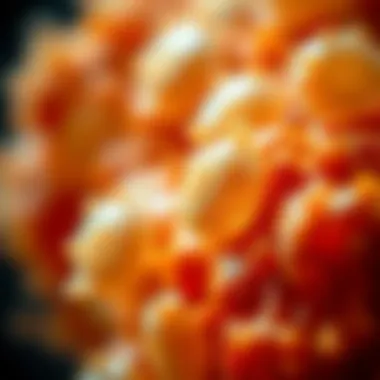Curcuminoids in Cancer Research: Impacts and Insights


Intro
As we navigate the intricate landscape of cancer treatment and prevention, curcuminoids—the active compounds in turmeric—are emerging as significant players in the realm of oncological research. These bioactive substances are not merely exotic spices from far-flung regions; rather, they represent a rich tapestry of potential therapeutic avenues worthy of thorough examination. By delving into curcuminoids, researchers aim to unravel their multifaceted roles, especially in combating cancer, a disease that has plagued humanity for centuries.
Overview of Research Topic
Brief Background and Context
Sourced from the turmeric root (Curcuma longa), curcuminoids, predominantly curcumin, have captured attention due to their anti-inflammatory, antioxidant, and anticancer properties. Historically, turmeric has held a place of reverence in traditional medicine systems, like Ayurveda. However, in modern science, researchers are methodically exploring how these compounds could play a crucial role in altering the course of cancer treatment.
Importance in Current Scientific Landscape
The significance of curcuminoids can be linked to their potential to minimize side effects associated with conventional cancer therapies while enhancing efficacy. As the scientific community seeks alternative strategies to address the limitations of existing treatments, the prospect of integrating curcuminoids into cancer care grows increasingly appealing.
Let’s now shift focus to the intricacies involved in the approaches used to study these compounds and their potential implications for future cancer therapies.
Methodology
Research Design and Approach
To augment our understanding, various studies have adopted different methodologies, including in vitro experiments, animal models, and clinical trials. These designs aim to highlight the mechanisms by which curcuminoids influence cancer pathways, such as apoptosis and angiogenesis. Some prominent methods include:
- Cell Culture Studies: Examining the effects of curcuminoids on various cancer cell lines to evaluate growth inhibition and apoptosis induction.
- Animal Studies: Offering insights into the bioavailability and systemic effects of curcuminoids in living organisms.
- Clinical Trials: Testing human responses to curcumin supplementation to assess its therapeutic benefits and safety.
Data Collection Techniques
The collection of data in studies focusing on curcuminoids typically includes:
- Biochemical Analysis: Measuring levels of markers significant in cancer progression following curcumin administration.
- Imaging Techniques: Utilizing MRIs or CT scans to visualize tumor responses to treatment.
- Patient Surveys and Interviews: Gathering subjective data on quality of life and side effects from participants undergoing treatment.
As the dialogue surrounding curcuminoids continues, it remains vital to ascertain the nuances of their bioavailability, dosing strategies, and the implications for integration into mainstream therapies. The ensuing sections will delve deeper into how these compound's unique characteristics can be harnessed to refine cancer care approaches.
Prelude to Curcuminoids and Cancer
The growing interest in the role of curcuminoids, particularly in the context of cancer research, speaks volumes about their potential therapeutic benefits. Curcuminoids, the active compounds in turmeric, have shown considerable promise in combating various forms of cancer. This article aims to delve deep into how these compounds may affect cancer treatment and prevention strategies. The significance of this topic lies in an ever-increasing need for innovative cancer therapies that go beyond conventional methods.
Definition and Background of Curcuminoids
Curcuminoids are a group of polyphenolic compounds derived mainly from the rhizome of Curcuma longa, commonly known as turmeric. They are responsible for the bright yellow color of turmeric, and the most studied among them are curcumin, demethoxycurcumin, and bisdemethoxycurcumin. Historically, turmeric has been used not only as a spice but also for its medicinal properties in various cultures, particularly in traditional Indian and Chinese medicine. Recent scientific investigations have been aimed at understanding how these bioactive compounds work at a molecular level, especially in relation to cancer.
Key Points on Curcuminoids:
- Curcuminoids are known for their anti-inflammatory and antioxidant properties.
- They exhibit a range of biological activities including anti-cancer effects, making them a focal point of oncology research.
- Their ability to modulate various signaling pathways implicated in cancer progression is especially promising.
Overview of Cancer Biology
Understanding cancer biology is critical when considering the impact of curcuminoids in cancer research. Cancer arises from the uncontrolled proliferation of abnormal cells, which can result from genetic mutations, environmental factors, and lifestyle choices. Essentially, this uncontrolled cell growth disrupts normal tissue function and can invade surrounding tissues or metastasize to distant sites.
Cancer can be categorized into various types, with each type having unique characteristics and behavioral patterns. Common types include breast cancer, lung cancer, prostate cancer, and colorectal cancer, among others. The complexity of cancer biology necessitates tailored approaches for treatment and prevention.
Important Concepts in Cancer Biology:
- Cell Cycle Regulation: Normal cells follow a regulated cycle for growth and division, which cancer cells often circumvent.
- Apoptosis: This is a programmed cell death mechanism, which cancer cells frequently evade to survive; curcuminoids may enhance apoptosis in malignant cells.
- Angiogenesis: The formation of new blood vessels that tumor cells utilize to obtain nutrients; curcuminoids may inhibit this process to starve tumors.
Samplings from research indicate that curcuminoids could potentially influence these processes, providing a novel angle for cancer management.
In summary, the exploration of curcuminoids in the realm of cancer research presents both a challenge and an opportunity. Given their potential bioactive capabilities, these compounds not only have the possibility to affect cancer treatment paradigms but also to pave the way for more comprehensive therapeutic strategies.
Mechanisms of Action


The mechanisms of action of curcuminoids, particularly in the realm of cancer research, delineate how these compounds function at the cellular and molecular levels. Understanding these pathways provides vital insight into their potential benefits in cancer prevention and treatment. Curcuminoids emerge not just as passive players in biological processes; they actively engage various pathways that influence cell growth, inflammation, and oxidative stress. This section summarizes three key mechanisms through which curcuminoids demonstrate their potential: their anti-inflammatory properties, antioxidant effects, and modulation of cell signaling pathways.
Anti-inflammatory Properties
Inflammation is an underlying factor in many chronic diseases, especially cancer. Curcuminoids possess remarkable anti-inflammatory properties, primarily through their interaction with several molecular targets. They work by inhibiting pro-inflammatory cytokines, which are proteins that facilitate inflammation. This activity is crucial because reducing inflammation can potentially interrupt cancer progression. Studies have shown that curcumin can suppress the activity of nuclear factor-kappa B (NF-kB), a protein complex that controls the transcription of DNA and plays a significant role in inflammatory responses.
Moreover, curcuminoids may also hinder the production of cyclooxygenase-2 (COX-2), an enzyme linked to inflammation and tumor growth. By curbing COX-2 activity, curcuminoids offer a pathway to lessen inflammation while concurrently impacting tumor dynamics. The capacity to manifest both anti-inflammatory and anticancer activities underlines how curcuminoids could be harnessed in therapeutic regimes.
Effective control of inflammation is crucial for preventing and treating cancer, making curcuminoids an exciting area of research.
Antioxidant Effects
Oxidative stress, resulting from an imbalance between free radicals and antioxidants in the body, is a significant contributor to cancer development. Curcuminoids exhibit strong antioxidant effects, which means they neutralize free radicals and protect cells from damage. This protective capacity is paramount, as cellular damage over time can lead to mutations, cellular senescence, and, ultimately, cancer.
Curcumin, one of the principal curcuminoids, has been observed to increase the levels of antioxidant enzymes, such as superoxide dismutase (SOD) and glutathione peroxidase. This biochemical boost enhances the body's own defense mechanisms against oxidative stress. Moreover, the unique structure of curcumin allows it to interact with multiple cellular pathways, augmenting its efficacy as an antioxidant. The implication is clear: by employing curcuminoids in lifestyle choices or therapeutic strategies, individuals may bolster their defenses against cancer through the enhancement of their antioxidant capabilities.
Modulation of Cell Signaling Pathways
The influence of curcuminoids on cell signaling pathways is multifaceted and essential to understanding their role in cancer treatment. These compounds modulate several key pathways, affecting cellular processes such as proliferation, apoptosis, and metastasis. Curcuminoids impact the phosphatidylinositol 3-kinase (PI3K)/Akt pathway, known for its role in cell survival and growth. Inhibition of this pathway by curcumin may lead to the promotion of programmed cell death (apoptosis) in cancer cells, presenting a promising approach for cancer therapy.
Additionally, curcuminoids can affect the mitogen-activated protein kinase (MAPK) signaling pathway and glycogen synthase kinase 3 (GSK-3), both of which are crucial in regulating cell fate decisions. By influencing these pathways, curcuminoids can help dictate whether cells survive or die, a significant factor in cancer progression and treatment. Understanding how these compounds impact signaling pathways provides a clearer picture of their therapeutic potential and paves the way for future developments in cancer care strategies.
In summary, the mechanisms through which curcuminoids operate reveal their potential for impactful roles in cancer research. From addressing inflammation and oxidative stress to modulating essential signaling pathways, they could transform approaches to both prevention and treatment.
Clinical Applications of Curcuminoids in Oncology
Understanding how curcuminoids may play a critical role in the realm of oncology is essential, as these compounds have piqued the interest of researchers worldwide. The potential benefits of curcuminoids extend far beyond the kitchen spice phase, permeating into cancer prevention and treatment strategies. By examining how these bioactive compounds function at different stages of cancer management, a clearer picture of their relevance begins to form.
Curcuminoids in Cancer Prevention
Cancer prevention is a paramount objective in oncology, and curcuminoids may prove to be valuable allies in this endeavor. Epidemiological studies indicate that populations with a high turmeric intake exhibit lower cancer rates. This correlation suggests that curcuminoids could contribute significantly to reducing the incidence of various cancer types.
Through mechanisms like inhibition of cell proliferation and immunomodulation, curcuminoids have shown promising effects. A few noteworthy points include:
- Anti-proliferative Effects: Curcuminoids can inhibit the growth of malignant cells, possibly through the regulation of cell cycle proteins.
- Apoptotic Induction: There’s evidence to suggest that curcuminoids can trigger apoptosis in some cancer cells, a process crucial for eliminating potentially harmful cells.
- Reduction of Inflammation: Chronic inflammation is a recognized risk factor for developing cancers. Since curcuminoids exhibit anti-inflammatory properties, they might reduce this risk.
A comprehensive analysis reveals that integrating curcuminoids into dietary practices or as a preventive supplement could help mitigate cancer risk, although more extensive studies are essential for validation.
Curcuminoids in Cancer Treatment
When it comes to cancer treatment, curcuminoids have also shown potential as adjunctive therapies. By complementing traditional methods, such as chemotherapy or radiation, curcuminoids could potentially enhance their effectiveness. Some important aspects of their role in treatment are:
- Enhancing Chemo-Efficacy: Curcuminoids might increase the susceptibility of cancer cells to certain chemotherapy agents. Studies indicate synergy between curcumin and taxanes.
- Reduction of Side Effects: Patients undergoing chemotherapy often experience debilitating side effects. Curcumoinds might help alleviate these symptoms, improving overall quality of life during treatment.
- Targeting Multiple Pathways: Curcuminoids have the unique ability to interact with several biochemical pathways involved in carcinogenesis, effectively hitting cancer from multiple angles.
Although clinical trials are necessary for more solid conclusions, the preliminary indications point towards the potential of curcuminoids as an integral part of comprehensive cancer treatment programs.
Synergy with Conventional Therapies
The concept of synergy in cancer treatment has garnered attention, and curcuminoids may offer a noteworthy edge in augmenting the effects of conventional therapies. Their capacity to boost the efficacy of existing cancer treatments is particularly exciting because it suggests a way to enhance clinical outcomes without additional toxicities. Key highlights regarding their synergy include:
- Combination with Radiation Therapy: Some studies hint at curcuminoids potentially enhancing the effects of radiation by making tumor cells more susceptible to radiation-induced damage.
- Co-administration with Chemotherapeutic Agents: Research showcases how the use of curcuminoids alongside specific chemotherapy agents, like doxorubicin and paclitaxel, can improve treatment response rates.
- Impact on Metastasis: There is emerging evidence suggesting that when combined with conventional treatments, curcuminoids may also help inhibit metastasis, a major hurdle in cancer therapy.
Bioavailability and Pharmacokinetics
The concept of bioavailability in the context of curcuminoids is crucial. It informs us about how much of a substance—the curcuminoids in this case—reaches the bloodstream after ingestion. High bioavailability means that a compound can effectively exert its beneficial effects in the body. For curcuminoids, their potential as a therapeutic agent in cancer research hinges heavily on how well our bodies can absorb and utilize these compounds. If they just pass through without making an impact, all the exciting research might fall flat.
One major consideration is that curcuminoids, despite being powerful, have notoriously low bioavailability. This leads us to a critical aspect of pharmacokinetics, which studies how substances move through the body. Imagine it as a relay race with various stages: absorption, distribution, metabolism, and excretion. Each stage interacts, and any hiccup can diminish the potential of curcuminoids to exert their benefits thoroughly. The implications of this are far-reaching in cancer treatment protocols.
Challenges in Absorption
Several factors contribute to the challenges of curcuminoid absorption. First up is solubility. Curcuminoids are poorly soluble in water. This means when they enter our gut, they don't dissolve well, making it harder for the cells lining the gastrointestinal tract to absorb them. Additionally, their rapid metabolism often leads them to be broken down before they can reach circulation in significant amounts.


Another obstacle is the presence of food and other nutrients in the stomach. Some compounds in food can either inhibit or enhance the absorption of curcuminoids. For instance, certain fats improve their solubility, but if not paired wisely, it could lead to variable outcomes. Lastly, gastrointestinal health plays a big role. Individuals with conditions like irritable bowel syndrome might find it more difficult to absorb curcuminoids compared to those with healthier gut flora.
Methods to Enhance Bioavailability
So, how do researchers and health professionals tackle this low bioavailability issue? Here are several innovative strategies being explored:
- Formulation Techniques: Researchers have been experimenting with creating nano-sized formulations. These can facilitate better absorption by increasing the surface area for absorption.
- Liposomes: These are tiny spherical vesicles that can encapsulate curcuminoids, improving their solubility and protection during digestion, making for a more effective delivery system.
- Biopolymer Coatings: Using natural polymers to coat curcuminoids can shield them from early degradation and release them slowly into the bloodstream.
- Combination with Absorption Enhancers: The co-administration of curcuminoids with piperine, an active component of black pepper, has shown promising results. Piperine can increase curcuminoid absorption significantly by inhibiting the enzymes that metabolize them too quickly.
Curcuminoids are indeed a promising area of study, especially in oncology. However, addressing bioavailability challenges is paramount for translating laboratory findings into effective clinical applications. The ongoing research on absorption enhancement methods may pave the way for harnessing the full potential of curcuminoids in combating cancer.
Current Research and Findings
The exploration of curcuminoids in cancer research showcases a vibrant frontier in oncological studies. Recent findings shed light on how these compounds, derived primarily from turmeric, offer promising avenues for both treatment and prevention. Understanding the current landscape of research helps underscore the significance of these bioactive compounds in modern medicine.
Recent Clinical Trials
In the realm of clinical trials, curcuminoids have been at the forefront of numerous studies aiming to assess their efficacy in various cancer types. For instance, a recent trial involving patients with colorectal cancer demonstrated that administering high doses of curcumin alongside standard therapies not only improved patient markers but also highlighted reduced side effects associated with traditional treatment methods.
- Enhanced Outcomes: Participants reported improved quality of life, which suggests that curcuminoids may play a supportive role in conjunction with other therapies.
- Dosing Variations: Additionally, different dosing regimens have been tested, revealing that a sustained low-dose regimen can serve as a more viable option in long-term management without overwhelming the patient’s system.
A notable study published in JAMA Oncology found a correlation between curcuminoid supplementation and reduced tumor size in patients undergoing treatment for pancreatic cancer. These findings suggest that curcuminoids may produce synergistic effects when paired with chemotherapy.
Laboratory Studies Highlighting Efficacy
Beyond clinical trials, laboratory studies have provided insightful evidence on the anticancer properties of curcuminoids. For instance, in vitro studies reveal that curcumin can induce apoptosis (programmed cell death) in various cancer cell lines, including breast, liver, and lung cancers. These findings are pivotal because they demonstrate curcumin's capability to target and eliminate cancerous cells.
Various mechanisms have been proposed to explain these effects:
- Cell Cycle Arrest: Curcumin has been shown to hinder cancer cell proliferation by arresting the cell cycle at specific checkpoints, which is essential for effective cancer treatment.
- Inhibition of Metastasis: Some studies indicate that curcumin may interfere with the pathways involved in cancer metastasis, thereby preventing the spread of malignant cells to other tissues.
Moreover, animal models have mirrored these encouraging results, showing tumor regression and enhanced survival rates with curcumin administration compared to control groups not receiving the compound. The collective evidence pushes forward the notion that curcuminoids could become a staple in comprehensive cancer treatment plans.
"The potential of curcuminoids in cancer research is not just a hopeful exaggeration; it’s grounded in solid science that encourages us to rethink our approach to treatment."
Continued research into both clinical and laboratory settings remains critical to fully elucidate the breadth of curcuminoids’ influence on cancer pathways. As we amass more data, it solidifies the future role of these compounds in integrative oncology strategies, combining the best of natural and conventional treatments.
Potential Side Effects and Interactions
Understanding the potential side effects and interactions of curcuminoids is crucial in the context of cancer research and treatment. While these compounds from turmeric exhibit many beneficial properties, it’s essential to be aware of the downside. This will facilitate informed decisions among practitioners and patients alike. Therefore, delving into this subject will enhance knowledge and ultimately optimize the use of curcuminoids in clinical settings.
Known Side Effects
Like any bioactive substance, curcuminoids aren’t without their own set of possible side effects. Many individuals using curcumin might face mild gastrointestinal issues. This can include symptoms like nausea, diarrhea, and bloating. In some cases, there could be instances of allergic reactions, although these are considered quite rare.
Specifically, here are some of the more common side effects associated with high doses of curcuminoids:
- Nausea
- Diarrhea
- Stomach ulcers
- Skin rash
Moreover, there is evidence to suggest that high doses may lead to disturbances in iron absorption, which could pose a risk, particularly for those who are already anemic or have iron deficiency.
"Before embarking on a curcuminoid supplement regimen, it is essential to consult with a healthcare provider to discuss any potential side effects and personal health conditions that may influence curcumin’s efficacy."
Drug Interactions of Concern
When considering curcuminoids, one must also be cautious about how they interact with other medications. There are several studies indicating that curcumin could influence the metabolism of certain drugs, particularly those broken down by the liver. Notably, curcumin has been shown to inhibit cytochrome P450 enzymes, which play a critical role in drug metabolism.
Specifically, potential drug interactions may include:
- Blood thinners like warfarin; curcumin could enhance the effect, leading to increased bleeding risks.
- Antidiabetic medications; curcumin may lower blood sugar levels, requiring dosage adjustments.
- Chemotherapy drugs; while curcumin may boost their effectiveness, there’s a risk that it could also enhance side effects.
It's prudent for patients undergoing treatment, especially those on such medications, to prioritize communication with healthcare providers and maybe even consider periodic monitoring.


In summary, while curcuminoids offer promising potential in cancer research, being aware of their side effects and interactions with medications is paramount. This points to the importance of healthcare guidance to mitigate risks and promote safe usage.
Future Directions in Curcuminoid Research
The exploration of curcuminoids and their role in cancer research is an evolving journey. As studies continue to unfold, emphasis on future directions in this field becomes essential. Understanding where curcuminoid research is headed opens the door to potential breakthroughs in cancer treatment and prevention. Given the promising anti-inflammatory and antioxidant properties of curcuminoids, insights from future studies could lead to innovative therapeutic strategies. This section delves into upcoming research avenues, focusing on innovative approaches and technology enhancements.
Innovative Research Approaches
Today, researchers are employing cutting-edge techniques that may enhance our understanding of curcuminoids. One noteworthy avenue is the increasing use of high-throughput screening methods. This technology allows scientists to quickly evaluate the effects of curcuminoids on various cancer cell types under diverse conditions. For instance, researchers can rapidly test thousands of compounds, promoting faster identification of effective formulations that could be harnessed for cancer therapy.
Moreover, multi-omics approaches are gaining traction. By integrating genomics, proteomics, and metabolomics data, researchers can gain a more holistic view of how curcuminoids interact with cancer biology. This strategy is not just about studying the effects of curcuminoids in isolation; it’s about understanding their role within the complex network of cellular processes.
"The integration of multi-omics data provides a promising pathway to decode the intricacies of curcuminoid interactions at a molecular level, paving the way for personalized cancer therapies."
Furthermore, using animal models that closely mimic human cancer progression can refine our understanding of curcuminoids’ actions. For instance, mouse models with specific genetic alterations allow researchers to observe how curcuminoids might alter tumor growth dynamics, offering vital information that may not be clear through cell culture studies alone.
The Role of Nanotechnology
Another exciting frontier is nanotechnology, which is poised to revolutionize the delivery of curcuminoids in chemotherapy settings. Standard delivery methods often suffer from low bioavailability and rapid elimination from the body. However, by encasing curcuminoids in nanoparticles, researchers can enhance their solubility and bioavailability. This innovation not only increases the amount of curcuminoids reaching cancer cells but also allows for sustained release over time.
Additionally, targeted delivery through nanoparticles could minimize side effects. For example, specific ligands can be attached to these nanocarriers that bind to cancer cell receptors, ensuring that the curcuminoids are delivered directly to the tumor site while sparing healthy tissues.
Current research indicates that such targeted methods can significantly elevate the therapeutic index — the ratio of the drug’s dose that produces a therapeutic effect to the dose that produces toxicity.
Although still in experimental stages, the convergence of nanotechnology and curcuminoids might lead to more effective treatments with fewer adverse effects. As studies continue in this direction, both principles of drug delivery and cancer therapy could be fundamentally transformed.
In summary, the future of curcuminoid research embraces innovative approaches and technological advancements that may redefine cancer treatment paradigms. Research in these directions is not just excitable but vital for uncovering the complete potential of curcuminoids as therapeutic agents.
Culmination
In the pursuit of understanding cancer and exploring the potential avenues for treatment and prevention, the role of curcuminoids emerges as a significant focal point. This conclusion synthesizes not just the information conveyed throughout the article but also highlights the broader implications of curcuminoid research in oncology. From their anti-inflammatory properties to their antioxidant effects, curcuminoids exhibit a multifaceted approach to combating cancer. Therefore, having a comprehensive summary of key points aids in grasping their importance.
Summary of Key Points
- Curcuminoids Are Bioactive Compounds: Derived from turmeric, curcuminoids serve as a source of various bioactive compounds that exhibit potential anticancer properties. Understanding their mechanisms is critical in cancer research.
- Mechanisms of Action: They function through pathways that modulate inflammation, oxidative stress, and cell signaling, painting a promising picture for cancer treatment strategies.
- Clinical Applications: Current research reflects their promise not only in prevention but also in enhancing results when paired with conventional therapies.
- Possible Side Effects and Interactions: Awareness of the side effects and interactions is vital to ensure safe and effective use.
- Challenges in Bioavailability: Issues with absorption have been noted, but methods to enhance bioavailability are under investigation, aiming to improve efficacy.
- Future Research Directions: Continuing exploration into innovative methods and applications of curcuminoids, including nanotechnology, could revolutionize cancer care.
Implications for Future Research and Practice
Looking ahead, the landscape of cancer treatment could greatly benefit from integrating curcuminoids into therapy protocols. However, future research must consider several elements:
- Innovative Research Approaches: There is a need to experiment with various formulations and delivery systems to overcome bioavailability challenges. This may involve collaborations with biochemists and pharmacologists.
- Longitudinal Studies: Continuing studies over extended periods can illuminate long-term benefits and any latent risks associated with curcuminoid consumption.
- Interdisciplinary Studies: Cancer research thrives on collaboration. By merging insights from different fields, such as nutrition and cellular biology, a more holistic understanding can improve treatment protocols.
- Regulatory Considerations: As curcuminoids transition from research to practical application, navigating regulatory requirements will be essential. Developing guidelines for dosage and safety can better inform clinical applications.
- Patient-Centric Research: Ultimately, the discoveries made must prioritize patient outcomes. This involves tailoring therapies that cater to individual needs and maximizing the therapeutic advantages of curcuminoids.
Curcuminoids hold the promise of making waves in cancer treatment, and their study intersects with key scientific disciplines. Keeping an eye on the research developments and embracing potential innovations could lead us to breakthroughs that redefine current understandings of cancer treatment strategies.
Importance of References
References serve several purposes that are essential to advancing understanding of any topic:
- Credibility and Authority: When scientific claims are backed by peer-reviewed studies or institutional reports, they carry more weight. References like PubMed and Google Scholar are invaluable for anyone looking to cite authoritative sources.
- Contextualization: Good references help place findings in a broader context. They allow scholars to see where curcuminoids fit within the existing landscape of cancer research, shedding light on how new discoveries align or contrast with past work.
- Facilitating Further Research: By providing references, researchers not only enhance the credibility of their work but also create pathways for others to follow. This is especially true in dynamic fields like oncology, where new treatments and therapies are evolving continually.
- Draw Connections: References help in linking concepts together. For instance, studies showing curcuminoids' anti-inflammatory properties may draw on various earlier works that detail inflammation's role in cancer progression. Without these connections, the narrative of research can appear disjointed.
"The beauty of science lies in its collaboration; each reference is a bridge, connecting minds and ideas."
Key Considerations About References
When compiling references for a comprehensive examination of curcuminoids in cancer research, several considerations should be kept in mind:
- Relevancy: The references chosen must directly relate to curcuminoids and cancer. Including peripheral studies can dilute focus.
- Recency: In a field as rapidly evolving as oncology, referencing the latest research ensures that discussions are grounded in up-to-date findings.
- Diversity of Sources: Incorporating a variety of perspectives, from clinical trials reported on databases like ClinicalTrials.gov to laboratory studies found in journals like Cancer Research, enriches the narrative.
- Impact Factor: Utilize journals with higher impact factors for critical claims to enhance credibility. Journals like Nature Reviews Cancer or The Lancet Oncology carry significant authority.
The End
In summation, references are not mere footnotes in the landscape of scientific writing; they are fundamental building blocks that enhance the clarity, credibility, and depth of any research article. Curcuminoids offer intriguing prospects in the context of cancer treatment, and the integral role of references cannot be sidelined in ensuring that the scientific community has access to accurate and valuable information.
For further reading and exploration of curcuminoids and their implications in cancer, consider these resources:
Engaging in responsible research practices and grounding conclusions in reliable references will pave the way for meaningful advancements in this promising field.



